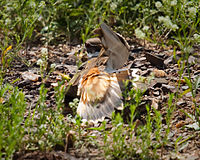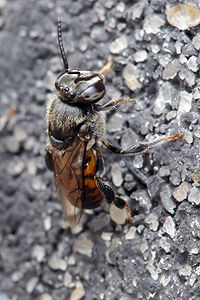
First description of injury feigning behavior in Godlewski's buntings
Sign Up to like & getrecommendations! Published in 2023 at "Ecology and Evolution"
DOI: 10.1002/ece3.10028
Abstract: Abstract Nest defense behavior helps ground‐nesting birds improve their breeding success. Among such behaviors, injury feigning behavior (IFB) is one of the better ways to attract predators and protect birds' nests. IFB is generally associated… read more here.
Keywords: behavior; injury feigning; nest defense; feigning behavior ... See more keywords

Face‐off: Novel depredation and nest defense behaviors between an invasive and a native predator in the Greater Everglades Ecosystem, Florida, USA
Sign Up to like & getrecommendations! Published in 2022 at "Ecology and Evolution"
DOI: 10.1002/ece3.8639
Abstract: Abstract We describe several photo‐documented novel interactions between intraguild predators in southern Florida—the native bobcat (Lynx rufus) and the invasive Burmese python (Python bivittatus). Over several days we documented a bobcat's depredation of an unguarded… read more here.
Keywords: python nest; face novel; nest defense; depredation ... See more keywords

Plasticity, state-dependency, and individual consistency in Canada goose nest defense behavior
Sign Up to like & getrecommendations! Published in 2019 at "Behavioral Ecology and Sociobiology"
DOI: 10.1007/s00265-019-2681-0
Abstract: Animals are thought to adjust the intensity of their parental defense to fitness benefits associated with their current reproduction. They should be more defensive when they breed early in the season, when they produce more… read more here.
Keywords: among individual; nest defense; canada goose; defense behavior ... See more keywords

Nest-defense behaviors in fathead minnows after lifecycle exposure to the antidepressant venlafaxine.
Sign Up to like & getrecommendations! Published in 2018 at "Environmental pollution"
DOI: 10.1016/j.envpol.2017.11.049
Abstract: Venlafaxine is an antidepressant and anti-anxiety drug that has been detected in municipal wastewater at low μg/L concentrations. In this study, the nest-defense behavior of adult male fathead minnows (Pimephales promelas) was observed in fish… read more here.
Keywords: lifecycle; defense behaviors; venlafaxine; fathead minnows ... See more keywords

Warblers perform less nest defense behavior and alarm calls to human intruders: A result of habituation
Sign Up to like & getrecommendations! Published in 2020 at "Global Ecology and Conservation"
DOI: 10.1016/j.gecco.2020.e01187
Abstract: Abstract Human disturbance is caused by the anthropogenic activities in the environment. While human threat to wildlife is considered to be complex (nonlethal recreations and lethal hunting activities). To date, there has been few studies… read more here.
Keywords: human disturbance; defense; alarm calls; defense behavior ... See more keywords

Fight or flight: Geographic variation in antipredator defenses by cinereous tits
Sign Up to like & getrecommendations! Published in 2020 at "Global Ecology and Conservation"
DOI: 10.1016/j.gecco.2020.e01207
Abstract: Abstract In the face of death from predation, parent birds have to choose between prioritizing current versus future reproduction. Previous studies have shown that when exposed to predation risk, birds breeding in the tropics prioritize… read more here.
Keywords: predation risk; cinereous tits; female birds; birds breeding ... See more keywords

Nonapeptides mediate trade-offs in parental care strategy
Sign Up to like & getrecommendations! Published in 2020 at "Hormones and Behavior"
DOI: 10.1016/j.yhbeh.2020.104717
Abstract: Parental care represents a suite of distinct behaviors performed by parents to maximize fitness. Dynamic shifts in parental care behaviors, such as between nest defense and direct provisioning of the offspring, are required in response… read more here.
Keywords: parental care; egg care; strategy; care ... See more keywords

Changing of the guard: mixed specialization and flexibility in nest defense (Tetragonisca angustula)
Sign Up to like & getrecommendations! Published in 2019 at "Behavioral Ecology"
DOI: 10.1093/beheco/arz047
Abstract: Task allocation is a central challenge of collective behavior in a variety of group-living species, and this is particularly the case for the allocation of social insect workers for group defense. In social insects, both… read more here.
Keywords: guarding tasks; tetragonisca angustula; flexibility; nest defense ... See more keywords

Geographical variation in nest defense among cinereous tit populations in China
Sign Up to like & getrecommendations! Published in 2022 at "Current Zoology"
DOI: 10.1093/cz/zoac019
Abstract: Abstract Behavioral divergence among populations is common across taxonomic groups, still we know very little about anti-predator behaviors. Animal exposure to predation risk is variable in different ecological contexts. In addition, reproduction value of animals… read more here.
Keywords: defense behaviors; defense; nest defense; response ... See more keywords